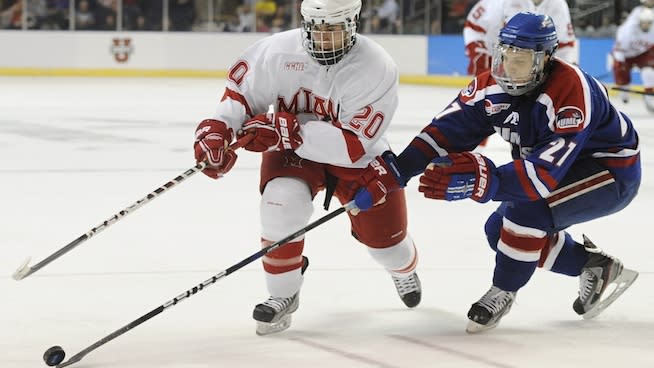4 Must-Have Physical Traits for Division I Hockey Players

College hockey coaches are all looking for athletes who are strong, fast and flexible, with healthy habits and a solid mental attitude.
If you're angling to make it into Division I hockey, here are four areas to concentrate on during your off-season training this summer.
WATCH: Henrik Zetterberg's Complete Workout
1. Core Stability
A stable core requires a stable trunk as well—meaning that in the weight room, you can keep your chest up while doing Deadlifts and Squats. The ability to keep your trunk stable while performing ballistic movements is important for proper skating posture and mechanics, shooting and giving and receiving checks.
Exercise Suggestions: Strict Form Deadlifts or Squats (both back and front)
RELATED: Is This The Best Core Exercise?
2. Deceleration
In hockey, most knee injuries occur when players slow down or attempt to change direction. It's important to learn proper deceleration techniques early on to prevent injury.
Exercise Suggestions: Progressive Box Jumps, Linear and Lateral Agility Drills
RELATED: How to Prevent Hockey Groin Injuries
3. Triple Flexion/Extension
Triple extension refers to extending at the ankle, knee and hip joints. This occurs during maximal thrust while you perform a skating stride. Without long, powerful strides, your speed is limited.
Triple flexion refers to bending the ankle, knee, and hip joint at a 90-degree angle. You see this when skaters punch their knee forward while bringing their striding skate back underneath their torso. Lack of adequate knee drive is a sign of poor skating technique.
Exercise Suggestions: Work through a full range of motion with all exercises
4. Combination of Fast/Slow-Twitch Muscle Fibers
High-level hockey players train both fast- and slow-twitch muscle fibers to develop a good mix of both (though genetics plays a big part, too.) You engage fast-twitch fibers when you sprint during shifts. They respond best to relatively low-volume, long-rest intervals, with high intensity and low frequency. Slow-twitch fibers affect the ability to play multiple shifts in a game. In contrast, they respond best to relatively high-volume, short rest intervals, low intensity and high frequency. Fast-twitch fibers have a significantly greater growth potential than slow-twitch.
Exercise Suggestions
Fast Twitch: Olympic lifts, Ballistic Med Ball Throws
Slow Twitch: Long Duration Bike Rides
This article originally appeared on STACK.com: 4 Must-Have Physical Traits for Division I Hockey Players

